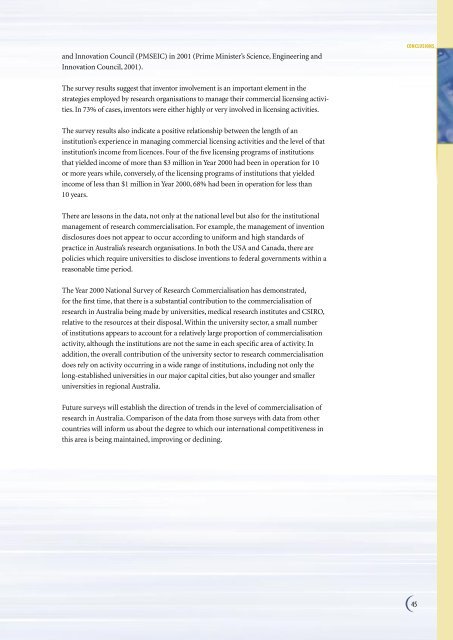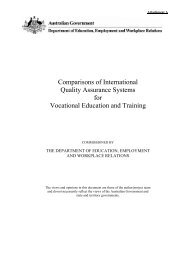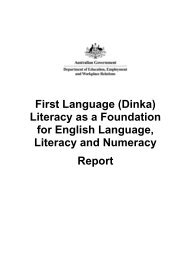National Survey of Research Commercialisation - Australian ...
National Survey of Research Commercialisation - Australian ...
National Survey of Research Commercialisation - Australian ...
Create successful ePaper yourself
Turn your PDF publications into a flip-book with our unique Google optimized e-Paper software.
and Innovation Council (PMSEIC) in 2001 (Prime Minister’s Science, Engineering and<br />
Innovation Council, 2001).<br />
CONCLUSIONS<br />
The survey results suggest that inventor involvement is an important element in the<br />
strategies employed by research organisations to manage their commercial licensing activities.<br />
In 73% <strong>of</strong> cases, inventors were either highly or very involved in licensing activities.<br />
The survey results also indicate a positive relationship between the length <strong>of</strong> an<br />
institution’s experience in managing commercial licensing activities and the level <strong>of</strong> that<br />
institution’s income from licences. Four <strong>of</strong> the five licensing programs <strong>of</strong> institutions<br />
that yielded income <strong>of</strong> more than $3 million in Year 2000 had been in operation for 10<br />
or more years while, conversely, <strong>of</strong> the licensing programs <strong>of</strong> institutions that yielded<br />
income <strong>of</strong> less than $1 million in Year 2000, 68% had been in operation for less than<br />
10 years.<br />
There are lessons in the data, not only at the national level but also for the institutional<br />
management <strong>of</strong> research commercialisation. For example, the management <strong>of</strong> invention<br />
disclosures does not appear to occur according to uniform and high standards <strong>of</strong><br />
practice in Australia’s research organisations. In both the USA and Canada, there are<br />
policies which require universities to disclose inventions to federal governments within a<br />
reasonable time period.<br />
The Year 2000 <strong>National</strong> <strong>Survey</strong> <strong>of</strong> <strong>Research</strong> <strong>Commercialisation</strong> has demonstrated,<br />
for the first time, that there is a substantial contribution to the commercialisation <strong>of</strong><br />
research in Australia being made by universities, medical research institutes and CSIRO,<br />
relative to the resources at their disposal. Within the university sector, a small number<br />
<strong>of</strong> institutions appears to account for a relatively large proportion <strong>of</strong> commercialisation<br />
activity, although the institutions are not the same in each specific area <strong>of</strong> activity. In<br />
addition, the overall contribution <strong>of</strong> the university sector to research commercialisation<br />
does rely on activity occurring in a wide range <strong>of</strong> institutions, including not only the<br />
long-established universities in our major capital cities, but also younger and smaller<br />
universities in regional Australia.<br />
Future surveys will establish the direction <strong>of</strong> trends in the level <strong>of</strong> commercialisation <strong>of</strong><br />
research in Australia. Comparison <strong>of</strong> the data from those surveys with data from other<br />
countries will inform us about the degree to which our international competitiveness in<br />
this area is being maintained, improving or declining.<br />
45

















